Apple Mac Pro (Mid 2010) Review
by Anand Lal Shimpi on October 6, 2010 9:26 PM ESTPerformance
The new Mac Pro is fast, but then again so was the old one. Earlier this year I tried using the 15-inch Core i7 MacBook Pro as my notebook and desktop - my experiment lasted all of a day, I missed the performance. It’s not so much an issue of peak performance, but one of core count and noise. While I rarely run applications that demand four (or more) cores, running a lot of applications that each eat 5 - 25% of a single core at the same time adds up. I also found that confined to a relatively thin notebook fans spun faster under typical CPU loads for me, as a result the overall system produced more noise than a larger tower.
I’ve got three Mac Pros represented in the charts below. The original late 2006 Mac Pro but upgraded to two 3.0GHz quad-core CPUs (effectively making it an early 2008 Mac Pro), the early 2009 Nehalem based Mac Pro once again upgraded to a pair of 2.93GHz quad-core CPUs and of course the new 2010 Mac Pro in its default eight-core configuration (2 x 2.4GHz quad-core CPUs).
Westmere only brought mild IPC improvements, so it shouldn’t really offer any tangible performance advantage over last year’s model. The only benefits will really be power, but let’s go down the list to put things in perspective.
Cinebench R10 & 11.5
Most applications won’t stress the 16 threads you get in the eight-core Mac Pro with the exception of offline 3D rendering of course. We’ll start out with Cinebench R10:
The single threaded shows how far we’ve come in single threaded performance just comparing Conroe to Nehalem. At roughly the same clock speed the 2009 Mac Pro manages a 25% performance improvement over the 2008 Mac Pro. Part of the advantage is obviously due to single threaded turbo mode, but it’s an advantage nonetheless. If you have a higher clocked Nehalem Mac Pro you’ll need to upgrade to something at least as fast as what you have now, the 2.4GHz default clock of the eight core system is simply too low to offer any advantage over the higher clocked alternatives in this chart.
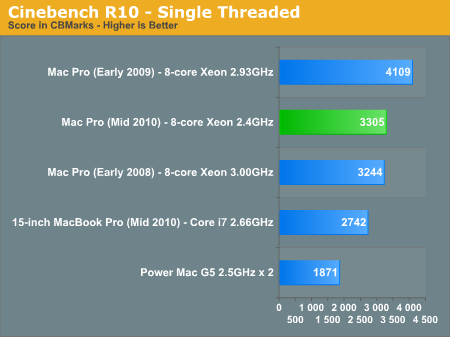
I also threw in the dual processor Power Mac G5 2.5GHz to put things in perspective. While a highly configured Mac Pro from 2008 may not be in need of an upgrade, if you’re still doing work on a Power Mac G5 an upgrade would be very appreciated. Westmere is 76% faster than the 2.5GHz G5 in this single threaded test.
Multithreaded performance scales very well on Nehalem and Westmere as you can see below:
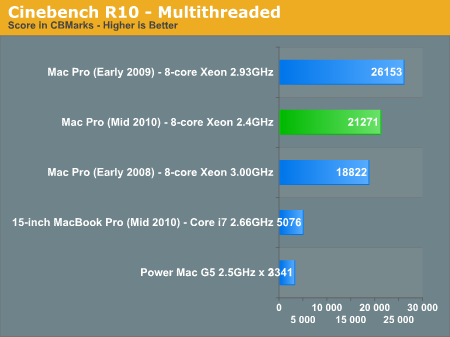
The key takeaway here is that if you had a high clocked, eight-core Mac Pro from 2008 you can’t get away with the new 2.4GHz eight-core. The extra threads help but you need clock speed as well to manage a significant performance advantage over what you’re upgrading from.
The G5 comparison is even more ridiculous when we look at multithreaded performance. A single Westmere core running at 2.4GHz is nearly as fast as two 2.5GHz PowerPC 970FXes in Cinebench R10’s multithreaded test.
We see a similar story if we look at Cinebench 11.5 results:
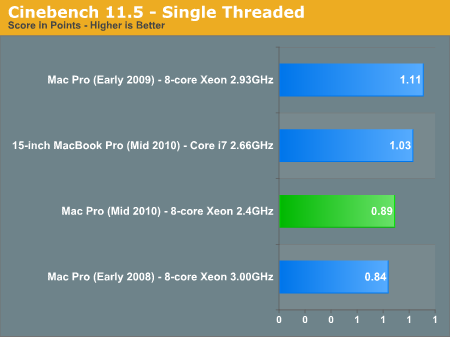
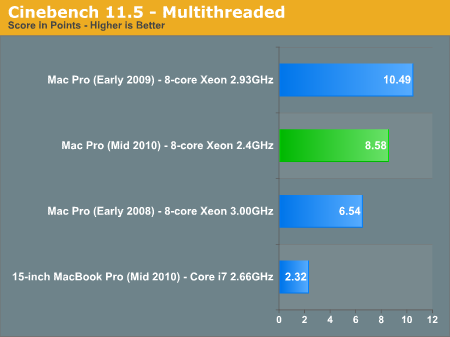
The newer benchmark is less bound by the performance of a single thread and thus we see it favoring the 2-threads-per-core you get from Nehalem/Westmere. In this case the 2.4GHz $3499 eight-core Mac Pro is faster than the 3.0GHz eight-core Mac Pro from 2008.
Remember that until Sandy Bridge, the L3 cache is the means of core-to-core communication in Intel’s Core series of processors. There was no single large shared cache in the 2006 - 2008 Mac Pro (each set of 2 cores shared an L2 cache) which is the reason for the relatively poor scaling there. Westmere gives you a larger L3 to play with and thus we see slightly better scaling from one to 16 threads vs. Nehalem. The size of the L3 cache in Westmere means that you can store more data shared by all of the cores in these heavily threaded applications.
Adobe Photoshop CS4 Performance
Photoshop is one of those benchmarks that really stresses everything. You get decent memory and I/O dependency and good use of multiple cores (but diminishing returns beyond 6 - 8 threads).
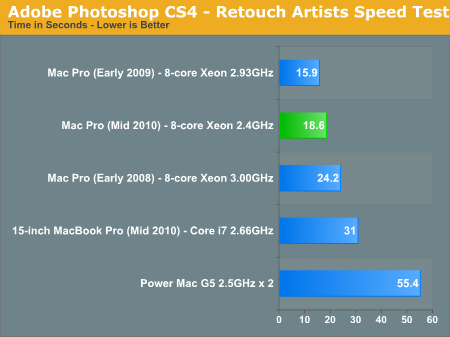
We’ve already shown the new Mac mini is nearly as fast as the Power Mac G5 in Photoshop, but the new Mac Pro cuts our test time in less than half compared to the old G5. The Westmere advantage is not tremendous here, some higher clocked Nehalems do better in this test.
Even the 2008 Mac Pro does well here, at least compared to the G5.
Aperture 2 RAW Import Performance
For my Aperture test I simply timed how long it took to import 203 12MP RAW images into the library.
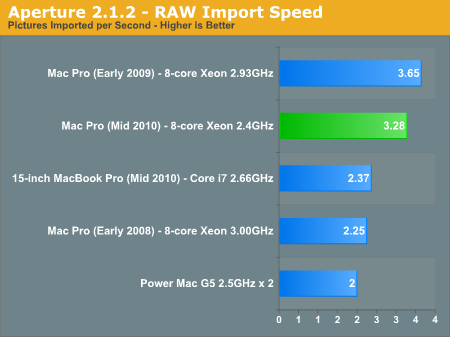
The 2009/2010 Mac Pros are very fast even in general use tasks like importing images into Aperture.
H.264 High Profile Transcoding
I have a feeling the transcoding game is going to get a lot more complicated after Sandy Bridge hits next year, but until then we’ve got our typical H.264 encoding tests. Here I’m taking a 90Mbps H.264 source file and transcoding it using Handbrake and the default High Profile settings.
The transcoding process peaks at about 11 threads, so there is an advantage to the Hyper Threading enabled systems but it’s not much. The sub-max thread count allows even the older 2008 Mac Pro to outpace the newcomer simply because of the system’s higher clocked CPUs in this case:
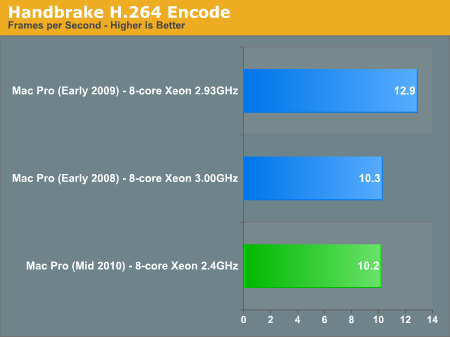
Clock for clock there is at least a 25% increase in performance over the old Mac Pro given the same number of cores. I wouldn’t expect a huge improvement vs. Nehalem at the same clock speed however.










84 Comments
View All Comments
Stas - Thursday, October 7, 2010 - link
No need for 750W PSU in the custom build. 500W would do just fine.$250 for a case... only Fortress 2, otherwise, GTFO. $150 LianLi would do just fine (oh, look, brushed aluminum, too O.O lol).
I say, you could build the custom for $1600 WITH the OS (especially if you shop around for MIR, coupons, etc.).
Nonetheless, very useful article. As a PC builder, I will forward this to my customers :D
DaveGirard - Friday, October 8, 2010 - link
If you actually put some newer GPUs in that machine and used them for rendering, you'd be cutting it too close at 500W.beammeup - Thursday, October 7, 2010 - link
So what Mac only workstation software is now out there that isnt available on a PC?Just wondering what the incentive is in a business environment to pay extra unless there are real tangible benefits to be had.
Also there is more price difference than just the GFX. The Dell comes with a 3 year warranty including on site support where as the Mac only comes with 1 year (its an extra $249 to upgrade that to 3 years)
xype - Thursday, October 7, 2010 - link
OS X? Apple Final Cut and Logic suites?mattgmann - Thursday, October 7, 2010 - link
nothing too special. Final Cut is the one everyone sites, but the fact is that premiere pro is just as, if not more capable. People just don't like (to learn) the interface.OSX is a cop-out excuse. It's just an operating system and doesn't increase productivity. In fact, it's horrific storage tools make file management a pain.
Stuka87 - Thursday, October 7, 2010 - link
The MacPro (And MacBook Pro) is used heavily in audio work as well. Take a step into most recording studios and you will see a Mac being used to edit and mix the tracks.Final Cut is used heavily in the movie industry, as is Aperture (photos are taken of the set, colors are adjusted, and once approved, the video is adjusted to match the colors in the photo).
DaveGirard - Friday, October 8, 2010 - link
No one uses Premiere in the professional world anymore. And it would just be a test of CUDA.seanleeforever - Friday, October 8, 2010 - link
final cut is pretty nice, but aperture is not a killer software.jags - Friday, October 8, 2010 - link
you really cannot argue with mac fanboys! they are pretty blind in their unwavering worship of apple. logic is NOT going to win here my friend.jags - Thursday, October 7, 2010 - link
Sorry this is a little out of context here and I apologize.This is a pretty good website and I come here frequently to check out new stuff. But is Anand a little obsessed with Apple or what? It seems Apple's the "only" thing he considers worth reviewing these days (for the most part). Come on, is everything else so low for you now? I know this is "anandtech" and you can write what you care about, but I am just asking.